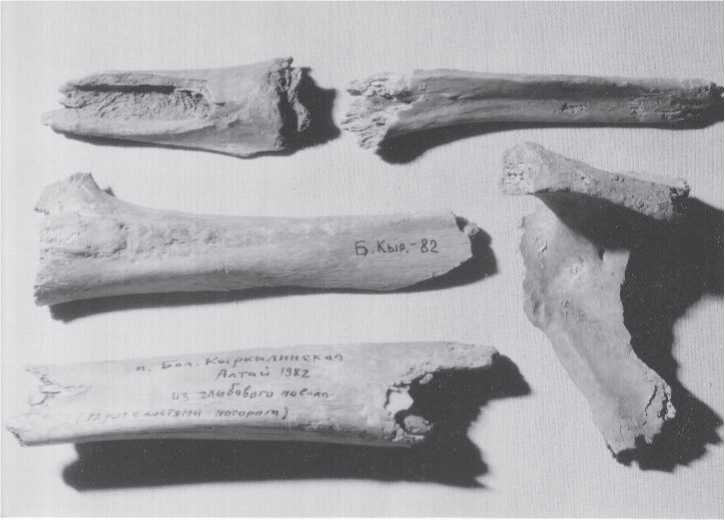1 Provenience. There are only four pieces in the Kirkalinskaya collection, making it 0.04% of our 8813-piece grand total (Table A1.1, site 11). We make no comparisons for this tiny assemblage, which was found on the surface within the cave near its entrance. There obviously had been a larger field collection, as seen in the above listing; however, this additional material could not be located in the IAE zooarchaeological storage area.
2 Species. All four pieces are goat-sheep (Table A1.2, site 11).
3 Skeletal elements. There is one piece each of the following: antler-horn, humerus, radius, femur (Table A1.3, site 11).
4 Age. One of the four pieces is of sub-adult age (Table A1.4, site 11).
5 Completeness. Two of the Kirkalinskaya pieces have one anatomical end, two have no anatomical ends (Table A1.5, site 11).
6 Maximum size. The four pieces have a mean size of 12.6 cm, and a range of 5.2 cm to 19.6 cm (Table A1.6, site 11).
7 Damage shape. One of the four pieces is a long bone flake, one is a phalanx segment, one is a phalanx butt, and one is mostly whole (Table A1.7, site 11).
8 Color. Each of the four Kirkalinskaya pieces is ivory colored (Table A1.8, site 11).
9 Preservation. All four pieces are ivory in hardness (Table A1.9, site 11).
10 Perimortem breakage. All four pieces have perimortem breakage (Table A1.10, site 11).
11 Postmortem breakage. One of the four pieces has postmortem breakage (Table A1.11, site 11).
12 End-hollowing. Two of the four Kirkalinskaya pieces have end-hollowing (Table A1.12, site 11).
13 Notching. One of the four pieces has notching. Six notches are present on the piece (Table A1.13, site 11).
14 Tooth scratches. Three of the four pieces have tooth scratches. One piece has one scratch, one has five scratches, and the other has more than seven scratches (Table A1.14, site 11).
15 Tooth dints. Only one piece has no dinting. One piece has four dints, one has five, and one has more than seven (Table A1.15, site 11).
16 Pseudo-cuts. One of the four Kirkalinskaya pieces has one pseudo-cut (Table A1.16, site 11).
17 Abrasions. None of the four pieces has abrasions (Table A1.17, site 11).
18 Polishing. Two of the four pieces have end-polishing, and two have end-middle polishing (Table A1.18, site 11).
19 Embedded fragments. None of the four pieces has embedded fragments (Table A1.19, site 11).
20 Tooth wear. There are no Kirkalinskaya teeth.
21-23, 25-26 Acid erosion, rodent gnawing, insect damage, cut marks, and chop marks.
None of these variables are present in the four Kirkalinskaya pieces (Tables A1.21, site 11 to A1.26, site 11).
24 Human bones. Human remains were recovered from this cave site, five pieces. The cause of damage is uncertain (Fig. 3.47).

Fig. 3.47 Kirklanskaya Cave human remains. Although the perimortem damage to these five pieces of human long bone and scapula fragment is attributed to animal-caused activity, the carnivore damage signature is minimal at best, and the human damage signature is absent. We have no explanation for the damage to these bones that likely are all from a single adult individual of indeterminable sex. Length of tibia fragment in lower left is 14.6 cm. Script on the tibia says: “From the boulder’s pile with rhinoceros bones, Altai, 1982.” The association with rhinoceros bones suggests a Pleistocene age for these remains (CGT neg. IAE 8-11-99:28A).




 World History
World History









